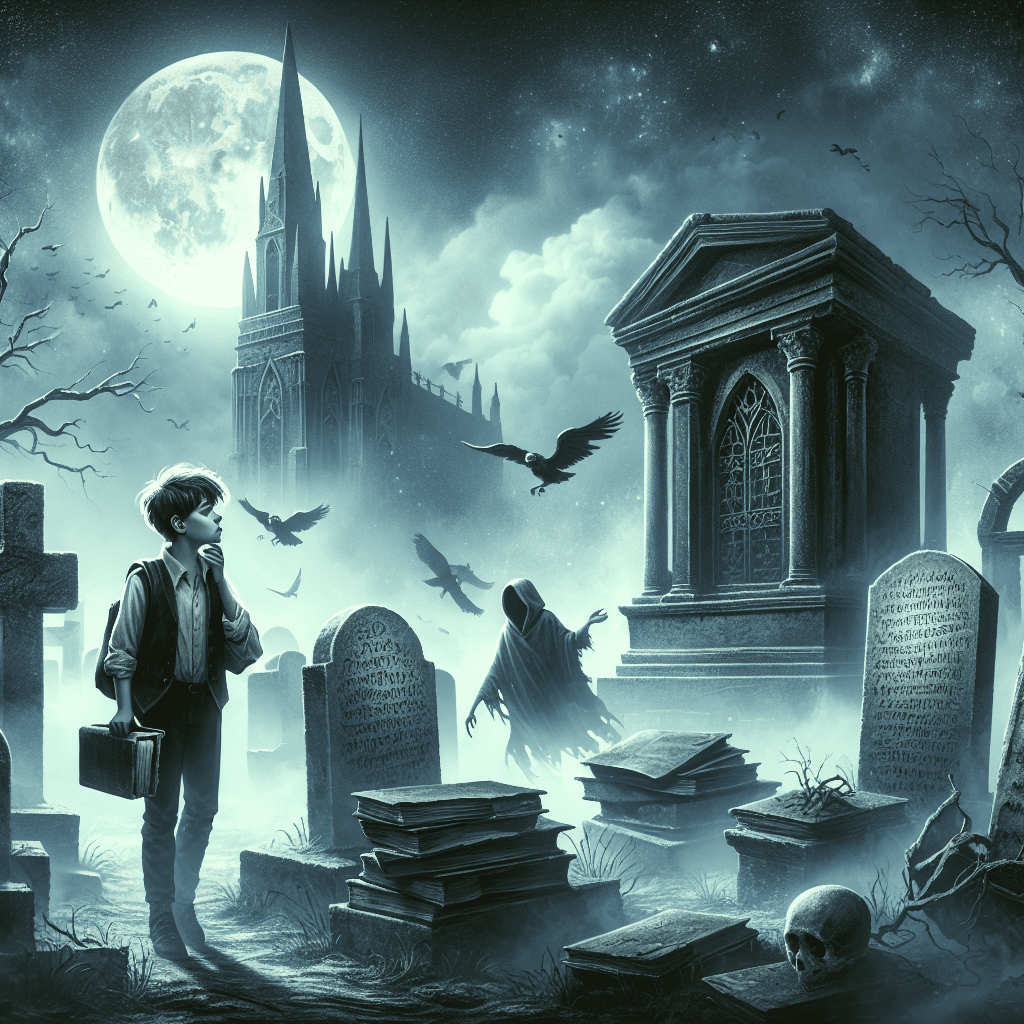-
Зміст
"Дослідіть моторошну подорож хлопчика, якого виростили привиди, у "Книзі цвинтаря" - історії про ідентичність, приналежність та боротьбу між життям і смертю".
"Книга на цвинтарі" Ніла Ґеймана - це унікальна історія про дорослішання, яка розповідає про життя Нікого Оуенса, хлопчика, якого після вбивства сім'ї виростили привиди на цвинтарі. У романі досліджуються теми ідентичності, приналежності та взаємодії між життям і смертю, оскільки Бод долає виклики дорослішання у нетрадиційному середовищі. Серед ключових персонажів - Бод, добросердий і допитливий головний герой, Сайлас, його загадковий опікун, і різні духи, що населяють цвинтар, кожен з яких робить свій внесок у розуміння Бодом світу. Завдяки багатому наративу та образному середовищу "Книга на цвинтарі" заглиблюється у складнощі дорослішання та важливість спільноти, навіть у найнесподіваніших місцях.
Короткий зміст книги "Цвинтар
"Книга цвинтаря", роман Ніла Ґеймана, представляє унікальну та захоплюючу оповідь, в якій переплітаються елементи фентезі, таємниці та теми дорослішання. Історія починається з трагічної події: вбивства сім'ї таємничою постаттю, відомою як Джек. У хаосі, що настає після цього, малюк на ім'я Ніхто Оуенс, або скорочено Бод, виривається з пазурів небезпеки і знаходить притулок на сусідньому кладовищі. Тут його всиновлюють духи померлих, які стають його опікунами та наставниками. Таке нетрадиційне виховання на цвинтарі закладає підґрунтя для надзвичайної подорожі Бода, в якій він пізнає складнощі життя, смерті та ідентичності.
У міру розгортання оповіді читачі знайомляться з багатим полотном персонажів, кожен з яких робить свій внесок у розвиток Бода. Серед них - Сайлас, вампір, який виконує роль батька і захисника, даючи Боду настанови і мудрість. Крім того, примарні мешканці кладовища, такі як загадкова міс Лупеску та грайливі привиди дітей, відіграють ключову роль у формуванні світогляду Бода. Через їхню взаємодію Ґейман досліджує теми приналежності та пошуку ідентичності, коли Бод намагається знайти своє місце як у світі живих, так і в царстві мертвих.
Цвинтар сам по собі слугує персонажем, лімінальним простором, що уособлює перетин життя і смерті. Саме в цьому середовищі Бод отримує цінні уроки про мужність, дружбу та важливість прийняття власної індивідуальності. З віком у Бода посилюється бажання досліджувати зовнішній світ, що змушує його зіткнутися з небезпеками, які ховаються за межами цвинтаря. Це прагнення до свободи та самопізнання є центральною темою роману, що відображає універсальну боротьбу підліткового віку.
Протягом усієї історії Ґейман використовує поєднання химерних і темних елементів, створюючи тон, який є водночас чарівним і моторошним. Зіставлення буденного і надприродного спонукає читачів замислитися над природою страху і невідомого. У міру того, як Бод стикається з різними викликами, зокрема з постійною загрозою з боку Джека, оповідь заглиблюється в теми смертності та важливості протистояння своїм страхам. Подорож Бода зрештою стає метафорою переходу від дитинства до дорослого життя, підкреслюючи важливість стійкості та мужності протистояти своєму минулому.
В останній частині роману пошуки ідентичності Бода завершуються конфронтацією з Джеком, який уособлює невирішену травму вбивства його сім'ї. Ця зустріч стає переломним моментом, що дозволяє Боду відновити свою оповідь і стати суб'єктом. Ця кульмінаційна зустріч слугує поворотним моментом, дозволяючи Боду відновити свою оповідь і утвердити власну суб'єктність. Вирішення цього конфлікту не лише свідчить про зростання Бода, але й посилює ідею про те, що розуміння власної історії є необхідним для прокладання шляху вперед.
Підсумовуючи, можна сказати, що "Книга цвинтаря" - це майстерне дослідження таких тем, як ідентичність, приналежність та складнощі життя і смерті. Через призму досвіду Бода Ніл Ґейман створює пронизливу історію, яка резонує з читачами різного віку. Взаємодія між живими і мертвими у поєднанні з багатим розвитком персонажів та атмосферною атмосферою створюють оповідь, яка спонукає до роздумів і глибоко захоплює. Зрештою, твір Ґеймана запрошує читачів замислитися над власними шляхами самопізнання, що робить "Книгу на кладовищі" позачасовою та резонансною історією.
Ключові теми книги "Цвинтар
У "Книзі цвинтаря" Ніла Ґеймана переплітаються кілька ключових тем, створюючи багате полотно, яке досліджує складнощі життя, смерті та дорослішання. Однією з найпомітніших тем є концепція ідентичності та приналежності. Головний герой, Ніхто Оуенс, або Бод, виховується на кладовищі привидами після того, як його сім'ю вбивають. Це унікальне виховання формує його ідентичність, оскільки він долає виклики, пов'язані з тим, як бути живим хлопчиком у світі, наповненому мертвими. Протягом усієї оповіді Бод намагається знайти своє місце як на цвинтарі, так і в зовнішньому світі, висвітлюючи універсальне прагнення до самопізнання та прийняття.
Ще однією важливою темою є ідея смерті та потойбічного життя. Ґейман представляє смерть не як щось, чого слід боятися, а як природну частину існування. Цвинтар слугує святилищем, де Бод дізнається про життя через історії та досвід його мешканців. Привиди, кожен зі своєю історією та жалем, передають мудрість, яка допомагає Боду зрозуміти цінність життя і неминучість смерті. Ця перспектива спонукає читачів замислитися над власними поглядами на смертність і спадщину, яку вони залишають після себе.
Більше того, тема сім'ї та приналежності вигадливо вплетена в оповідь. Хоча біологічна сім'я Бода трагічно загинула, він знаходить нову родину серед мешканців цвинтаря. Стосунки, які він будує з привидами, зокрема зі своїм опікуном Сайласом, ілюструють ідею про те, що сім'я може визначатися любов'ю і зв'язком, а не лише кровною спорідненістю. Ця тема знаходить відгук у читачів, підкреслюючи, що справжню приналежність можна знайти в несподіваних місцях і серед нетрадиційних супутників.
Тема дорослішання та переходу від дитинства до дорослого життя також є центральною в цій історії. Дорослішаючи, Бод стикається з різними викликами, які випробовують його мужність і стійкість. Його зустрічі з живим світом, зокрема зі зловісною постаттю Джека Мороза, стають ключовими моментами в його розвитку. Цей досвід змушує Бода протистояти своїм страхам і врешті-решт прийняти свою ідентичність як живого хлопчика. Ґейман майстерно передає суть дорослішання, зображуючи його як подорож, сповнену як дива, так і небезпеки.
Крім того, тема вибору та наслідків відіграє вирішальну роль в історії Бода. Протягом усього роману Бод стикається з рішеннями, які формують його шлях і впливають на його стосунки. Вибір, який він робить, чи досліджувати зовнішній світ, чи прислухатися до порад своїх примарних опікунів, підкреслює важливість власної волі у формуванні власної долі. Ця тема резонує з читачами, нагадуючи їм, що їхній вибір має тривалий вплив на їхнє життя та життя інших людей.
Отже, "Книга цвинтаря" - це багатогранне дослідження тем, які глибоко резонують з читачами різного віку. Через подорож Бода Ґейман заглиблюється у складнощі ідентичності, природу смерті, значення сім'ї, виклики дорослішання та важливість вибору. Кожна тема тісно пов'язана між собою, створюючи оповідь, яка спонукає до роздумів та викликає емоційний резонанс. Разом із Бодом у його подорожі читачі запрошуються до роздумів про власне життя, стосунки та вибір, який їх визначає, що робить "Книгу на цвинтарі" позачасовою історією, яка продовжує захоплювати та надихати.
Аналіз характеру Бода в "Книзі цвинтаря
У "Книзі цвинтаря" Ніла Ґеймана головний герой, Ніхто Оуенс, ласкаво відомий як Бод, слугує переконливим фокусом для дослідження тем ідентичності, приналежності та перетину життя і смерті. Характер Бода вигадливо виписаний і відображає складнощі дорослішання у нетрадиційному середовищі. Вихований привидами на кладовищі після трагічного вбивства своєї сім'ї, Бод виховується під впливом як надприродного, так і земного, що дозволяє Ґейману заглибитися в нюанси дитинства та пошуків самопізнання.
Від самого початку Бод зображений невинною дитиною, допитливою і спраглою до пізнання навколишнього світу. Його взаємодія з мешканцями кладовища, включно з примарними постатями, які стають його опікунами та наставниками, підкреслює його адаптивність та стійкість. Незважаючи на оточення мертвих, Бод виявляє природну цікавість до життя, що відрізняє його від інших мешканців цвинтаря. Ця цікавість спонукає його досліджувати світ за межами свого примарного дому, що призводить до зустрічей зі світом живих, які кидають виклик його розумінню ідентичності та приналежності.
Дорослішаючи, Бод бореться з подвійністю свого існування. Він не є ані повністю живим, ані повністю мертвим, що створює відчуття відчуженості. Ця тема граничності є центральною для розвитку характеру Бода, оскільки він долає складнощі підліткового віку, формуючись під впливом уроків, які дають йому його примарні опікуни. Наприклад, образ Сайласа, який виконує роль батька для Бода, втілює напругу між живими і мертвими. Настанови Сайласа допомагають Боду зрозуміти важливість обох світів, що, зрештою, впливає на його шлях до самоприйняття.
Більше того, стосунки Бода з іншими персонажами на цвинтарі ще більше висвітлюють його характер. Привиди, кожен зі своїми історіями та жалем, передають мудрість, яка формує моральний компас Бода. Наприклад, образ пані Лупеску знайомить Бода з поняттям жертовності та важливістю розуміння власних обов'язків. Завдяки цій взаємодії Бод засвоює цінні життєві уроки, які сприяють його зростанню і розумінню того, що означає бути людиною, незважаючи на його унікальні обставини.
Коли Бод вирушає у світ живих людей, він стикається з викликами, які випробовують його особистість і стійкість. Його досвід спілкування з живими дітьми, зокрема дружба зі Скарлетт, розкриває його прагнення до зв'язку та прийняття. Ці взаємодії підкреслюють тему приналежності, оскільки Бод намагається примирити своє примарне виховання з бажанням вписатися серед живих. Ця напруга гостро ілюструється, коли Бод стикається з упередженням і страхом з боку тих, хто не розуміє його походження, що змушує його зіткнутися з реальністю свого існування.
Зрештою, розвиток персонажа Бода завершується глибоким усвідомленням природи життя і смерті. Наприкінці оповіді він сприймає свою ідентичність як міст між двома світами, визнаючи, що його досвід унікальним чином дав йому змогу орієнтуватися в обох світах. Це визнання не лише свідчить про зростання Бода, але й підсилює наскрізні теми роману, підкреслюючи важливість розуміння свого минулого для прокладання шляху в майбутнє.
Отже, Ніхто Оуенс - це всебічно розвинений персонаж, чия подорож уособлює суть "Книги цвинтаря" Ніла Ґеймана. Через досвід Бода читачам пропонується замислитися над складнощами ідентичності, значенням приналежності та крихким балансом між життям і смертю. Образ Бода, створений Ґейманом, слугує гострим нагадуванням про те, що наш досвід, яким би нетрадиційним він не був, формує те, ким ми є і як ми ставимося до світу навколо нас.
Роль привидів у "Книзі цвинтаря
У "Книзі цвинтаря" Ніла Ґеймана привиди відіграють ключову роль, виступаючи не лише мешканцями цвинтаря, а й важливими персонажами, які формують шлях головного героя. Оповідь розгортається в унікальному місці, де співіснують живі та мертві, що дає змогу глибоко дослідити такі теми, як ідентичність, приналежність та плин часу. Привиди, кожен з яких має свою індивідуальність та історію, роблять значний внесок у розвиток Бода, хлопчика, якого виховали духи кладовища після трагічного вбивства його сім'ї.
Присутність привидів у цій історії виконує кілька функцій. По-перше, вони дають Боду відчуття сім'ї та спільноти, якого йому бракує у зовнішньому світі. Вихований примарними мешканцями, серед яких мудрий і турботливий Сайлас, Бод засвоює цінні життєві уроки, які формують його характер. Сайлас, який виступає в ролі опікуна і наставника, уособлює складнощі існування між життям і смертю, проводячи Бода через виклики, з якими він стикається. Ці стосунки висвітлюють тему нетрадиційних сімейних структур, підкреслюючи, що любов і підтримка можуть прийти з несподіваних джерел.
Більше того, привиди у "Книзі цвинтаря" - це залишки колись прожитих життів, кожен зі своїми історіями та жалем. Спілкуючись із Бодом, вони передають йому мудрість і знання, дозволяючи зрозуміти світ за межами цвинтаря. Наприклад, персонаж пані Лупеску знайомить Бода з концепцією "Божих псів", розповідаючи йому про небезпеки, які ховаються за межами захисних кордонів кладовища. Ця освіта має вирішальне значення для розвитку Бода, оскільки готує його до неминучої конфронтації з живим світом, де він повинен орієнтуватися в складнощах людських стосунків і суспільних норм.
Крім того, привиди слугують метафорою минулого та спогадів, які формують ідентичність людини. Кожен привид несе на собі тягар свого досвіду, і їхні історії переплітаються з подорожжю Бода, ілюструючи, як минуле впливає на теперішнє. Ця тема резонує впродовж усієї оповіді, коли Бод бореться з власною ідентичністю та спадщиною своєї родини. Привиди заохочують його прийняти свої унікальні обставини, водночас нагадуючи йому про важливість пам'ятати тих, хто жив до нього.
З розвитком сюжету роль привидів змінюється, особливо коли Бод починає відстоювати свою незалежність. Цвинтар, що колись був святилищем, стає місцем одночасно комфорту та ув'язнення. Взаємодія Бода з живим світом змушує його зіткнутися з обмеженнями його примарного виховання. Привиди, хоч і підтримують його, але водночас уособлюють світ, який Бод зрештою мусить залишити позаду. Ця напруга між безпекою кладовища і привабливістю зовнішнього світу підкреслює тему дорослішання і неминучого переходу від дитинства до дорослості.
Отже, привиди в "Книзі цвинтаря" - це не просто примарні постаті; вони є невід'ємною частиною розвитку Бода і тематичного багатства оповіді. Завдяки їхнім настановам Бод дізнається про кохання, втрати та складнощі життя. Взаємодія між живими і мертвими слугує гострим нагадуванням про взаємопов'язаність усіх істот, підкреслюючи, що нашу ідентичність формує як наше минуле, так і наші стосунки. Зрештою, зображення Ґейманом привидів спонукає читачів замислитися над природою існування та тривалим впливом тих, хто жив до нас.
Теми дорослішання у "Книзі на цвинтарі
У "Книзі цвинтаря" Ніла Ґеймана тема дорослішання вигадливо вплетена в оповідь, забезпечуючи глибоке дослідження ідентичності, приналежності та переходу від дитинства до дорослого життя. Головний герой, Ніхто Оуенс, або Бод, представлений як малюк, який уникає трагічної долі, коли його сім'ю вбивають. Він знаходить притулок на кладовищі, де його всиновлюють і виховують духи померлих. Це унікальне місце слугує метафорою межового простору між життям і смертю, відображаючи власну подорож Бода через складнощі дорослішання.
У роки свого становлення Бод стикається з проблемами ідентичності та самопізнання. Цвинтар, хоча і є місцем безпеки та виховання, водночас символізує ізоляцію. Виховання Бода серед привидів підкреслює його боротьбу за примирення людської природи з надприродними впливами, що його оточують. Ця двоїстість є центральним аспектом його досвіду дорослішання, оскільки він вчиться сприймати як свою спадщину, так і світ за межами кладовища. Напруга між його прагненням до зв'язку з живими і прив'язаністю до мертвих підкреслює універсальну боротьбу підлітків, які шукають своє місце у світі.
Більше того, взаємодія Бода з різними персонажами на цвинтарі висвітлює різні грані його розвитку. Такі постаті, як Сайлас, його опікун, та інші духи дають йому настанови і мудрість, але водночас вони втілюють і обмеження середовища, в якому живе Бод. Сайлас, зокрема, являє собою міст між живими і мертвими, пропонуючи Боду розуміння складнощів життя, а також нагадуючи йому про неминучість смерті. Ці стосунки підкреслюють важливість наставництва у процесі дорослішання, оскільки Бод отримує цінні уроки про мужність, любов і втрати.
Коли Бод виходить за межі цвинтаря, він стикається з живим світом, який несе в собі як можливості, так і виклики. Його досвід спілкування з дітьми його віку, особливо у формі дружби та конфліктів, ще більше ілюструє випробування дорослішання. Ці взаємодії змушують Бода протистояти власній ідентичності та суспільним нормам, що регулюють людську поведінку. Контраст між позачасовістю цвинтаря та динамічністю зовнішнього світу підкреслює складнощі підліткового віку, коли людина мусить прокладати власний шлях, борючись із зовнішніми очікуваннями.
Тема приналежності також є ключовою у подорожі Бода. Протягом усієї оповіді він шукає визнання як серед живих, так і серед мертвих, що відображає універсальне прагнення до зв'язку, яке характеризує досвід дорослішання. Його остаточне усвідомлення того, що він повинен викувати власну ідентичність, відокремлену від впливу кладовища, знаменує собою значний поворотний момент у його розвитку. Кульмінацією цього пошуку приналежності стає рішення Бода прийняти свою людську сутність, що символізує перехід від дитячої невинності до обов'язків дорослого життя.
Насамкінець, "Книга цвинтаря" майстерно досліджує тему дорослішання через призму унікального виховання та досвіду Бода. Оповідь Ґеймана захоплює суть дорослішання, висвітлюючи боротьбу за ідентичність, приналежність і неминуче протистояння зі смертю. У міру того, як Бод вчиться орієнтуватися в складнощах життя, він уособлює стійкість і мужність, які визначають шлях від дитинства до дорослості, що робить його історію гострим роздумом про універсальні виклики дорослішання.
Значення сім'ї у "Книзі на цвинтарі
У "Книзі цвинтаря" Ніла Ґеймана тема сім'ї постає центральним елементом, що формує оповідь і подорож головного героя. Історія розповідає про Нікого Оуенса, ласкаво відомого як Бод, якого виховують духи кладовища після трагічної загибелі його сім'ї. Це нетрадиційне виховання підкреслює багатогранну природу сім'ї, ілюструючи, що родинні зв'язки можуть виходити за рамки традиційних визначень і проявлятися в несподіваних формах. Оскільки Бод орієнтується в унікальному середовищі, кладовище стає для нього сурогатною сім'єю, надаючи йому настанови, захист і відчуття приналежності.
Значення сім'ї у "Книзі цвинтаря" підкреслюється розмаїттям персонажів, які населяють життя Бода. Кожна примарна постать втілює різні аспекти батьківської турботи та наставництва. Наприклад, Сайлас, який служить опікуном Бода, відіграє вирішальну роль у його розвитку. Хоча Сайлас не є традиційним батьком, він пропонує Боду мудрість і підтримку, гарантуючи, що той отримає необхідні життєві навички, а також захищає його від небезпек зовнішнього світу. Ці стосунки ілюструють ідею про те, що сім'я може визначатися любов'ю та відданістю, а не лише біологічними зв'язками.
Більше того, мешканці кладовища у різний спосіб сприяють вихованню Бода, кожен з них дає унікальні уроки, які формують його характер. Присутність відьми, поета і солдата збагачує розуміння Бодом життя, смерті і складності людського досвіду. Через їхні історії та взаємодію Бод дізнається про мужність, співчуття та важливість спільноти. Таке колективне виховання відображає уявлення про те, що сім'я може бути колективним утворенням, де люди збираються разом, щоб підтримувати і направляти один одного, незалежно від їхнього походження.
Коли Бод дорослішає, тема сім'ї все більше переплітається з його пошуком ідентичності. Його прагнення до зв'язку з живим світом підкреслює притаманне людині прагнення до приналежності. Хоча цвинтар пропонує йому безпеку і любов, подорож Бода також підкреслює важливість пошуку свого коріння і розуміння свого місця в ширшому життєвому полотні. Ця подвійність ілюструє, що сім'я - це не лише ті, хто нас виховує, а й стосунки, які ми будуємо, і спільноти, в яких ми живемо.
Контраст між життям Бода на цвинтарі та зовнішнім світом ще більше підкреслює значення сім'ї. Небезпеки, що чатують за воротами цвинтаря, нагадують про крихкість життя і захисну природу родинних зв'язків. Коли Бод стикається з різними викликами, в тому числі із загрозою з боку Джека, який прагне завершити розпочате, сила його сім'ї на цвинтарі стає очевидною. Їх непохитна підтримка та самопожертва підкреслюють ідею про те, що справжня сім'я стоїть поруч один з одним у часи небезпеки.
Зрештою, "Книга на цвинтарі" представляє тонке дослідження сім'ї, ілюструючи, що вона може набувати різних форм та існувати в різних контекстах. Через досвід Бода Ґейман запрошує читачів замислитися над природою родинної любові, важливістю спільноти та способами, якими ми визначаємо наші зв'язки з іншими. У світі, де традиційні сімейні структури не завжди присутні, роман слугує гострим нагадуванням про те, що любов, підтримка та приналежність можна знайти в найнесподіваніших місцях, формуючи нашу ідентичність та спрямовуючи нас через життєві виклики.
ПИТАННЯ ТА ВІДПОВІДІ
1. **Який короткий зміст "Книги на цвинтарі"?
"Книга на цвинтарі" - це історія хлопчика на ім'я Ніхто Оуенс, якого після вбивства його сім'ї виховують привиди на кладовищі. Підростаючи, він дізнається про життя, смерть і світ за межами цвинтаря, стикаючись з небезпеками, які несе вбивця його родини.
2. **Які основні теми "Книги на цвинтарі"?
Серед ключових тем - пошук ідентичності, концепція приналежності, природа життя і смерті, а також важливість спільноти і сім'ї, як біологічної, так і обраної.
3. **Хто є головним героєм "Книги на цвинтарі"?
Головний герой - Ніхто "Бод" Оуенс, хлопчик, якого після втечі від убивці виховують духи кладовища.
4. **Хто є важливими персонажами книги?
Серед важливих персонажів - Сайлас, опікун Бода, який ні живий, ні мертвий; міс Лупеску, перевертень, яка вчить Бода пізнавати світ; і чоловік Джек, антагоніст, який убив родину Бода.
5. **Яку роль відіграє цвинтар в оповіданні?
Цвинтар слугує безпечним притулком для Бода, забезпечуючи йому унікальне виховання серед привидів і надприродних істот, а також представляє собою межу між життям і смертю.
6. **Як розвивається характер Бода протягом історії?
Бод перетворюється з допитливої та наївної дитини на більш самосвідомого та сміливого юнака, який вчиться протистояти своїм страхам і врешті-решт зустрічається з людиною, яка загрожує його життю. "Книга на цвинтарі" Ніла Ґеймана - це історія Ніхто Оуенса, хлопчика, якого після вбивства його сім'ї виростили привиди на цвинтарі. У романі досліджуються теми ідентичності, приналежності та переходу від дитинства до дорослого життя. Ключовими персонажами є головний герой Бод, його опікун Сайлас та різні привиди, які впливають на його виховання. Історія підкреслює важливість спільноти, вплив вибору та боротьбу між життям і смертю. Зрештою, вона висвітлює шлях самопізнання та прийняття свого унікального місця у світі.




